At 10am GMT on Monday morning an alarm clock will rouse a snoozing spacecraft that is hurtling through the darkest reaches of the solar system. Launched 10 years ago, and in hibernation for the last three, the time for action has come at last.
The European Space Agency's Rosetta probe aims for a spectacular first in space exploration. The billion-euro machine will catch up with a comet, circle it slowly, and throw down a lander to the surface. With gravity too weak to keep it there, the box of electronics and sensors on legs will cling to its ride with an explosive metal harpoon.
Together, the Rosetta probe and its lander, Philae, will scan and poke the comet as it tears towards the sun. As the comet draws near, it will warm and spew huge plumes of gas and dust in a tail more than one million kilometres long. The spectacle has never been captured up close before.
The comet, named 67P/Churyumov-Gerasimenko, formed from cosmic debris 4.6bn years ago, before material had coalesced to form the Earth and our nearest planets, and the sun was a newborn star. Even rocket scientists find the comet's name hard work. Some opt instead for "Chury".
By studying the comet – some of the most pristine and primordial material there is – scientists hope to learn more about the origins of the solar system. The presence of ice, and traces of organics, might hint at answers to other big questions: how Earth got its water and how life began. But first the spacecraft must wake up.
Rosetta was put into hibernation in June 2011 when its trajectory took it so far from the sun – beyond the orbit of Jupiter – that light reaching its solar panels was too feeble to provide power. Mission scientists deliberately built in the dormant stage of its voyage, but the silence is still nerve-wracking. No one has heard from the spacecraft since.
This article includes content provided by Spotify. We ask for your permission before anything is loaded, as they may be using cookies and other technologies. To view this content, click 'Allow and continue'.
For mission controllers, Monday will be a day of finger-tapping and watching the clock. If all goes to plan, at 10am on the dot, an electronic circuit will stir into life on the spacecraft, which is more than 700m kilometres from Earth and almost as far out in the solar system as the orbit of Jupiter. First to switch on will be heaters hooked up to Rosetta's star trackers. Once they have warmed up, they will stare into space and, from the positions of the stars, work out which way the probe is facing.
When Rosetta has gained its bearings, thrusters will fire to stop the spacecraft from spinning. Next, they will turn the probe so its antenna points to Earth. Only then, perhaps eight hours after the alarm clock sounds, can Rosetta send a message home. "There's apprehension and excitement. Some people have put their lives into this," said Matt Taylor, project scientist on Rosetta at the European Space Agency in the Netherlands. "But it's a bit like a teenager waking up. It takes some time to get out of bed."
Mission controllers will spend the next three months checking that the systems and scientific instruments onboard Rosetta and its lander are in working order. The spacecraft is bearing down on the comet at more than 3,500km per hour, so in May the spacecraft must pull a major braking manoeuvre to slow its approach to walking speed.
Once Rosetta has moved alongside the comet, it will steer itself into an orbit that takes it within 20km of the surface. From here, its cameras can begin to map the surface and search for a landing spot for Philae. The comet is 4km wide, roughly the size of Mont Blanc, and the surface is unlikely to be smooth.
Placing a lander on a speeding comet has never been achieved for a reason: it is extraordinarily difficult. After scouring the surface for hazards, mission controllers will send details of their chosen landing site and flight instructions to Rosetta, but from then on the process will be automatic. The communications delay makes it impossible to control the spacecraft directly from Earth.
Rosetta will perform a series of manoeuvres in November to bring it within three kilometres of the comet's surface. From here, the spacecraft can lob Philae straight down to its landing site. Rosetta must compensate for movement of the comet, so the lander does not slide or tumble when it makes contact. When Philae touches down, an explosive harpoon will fire into the ground, with luck holding the lander steady.
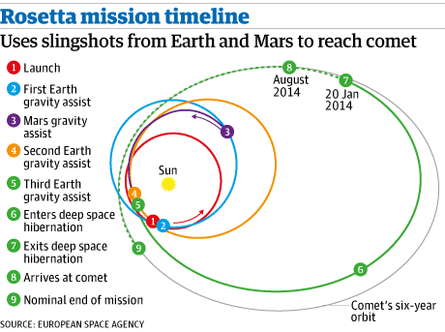
For Hermann Boehnhardt, an astronomer at the Max Planck Institute for Solar System Research in Lindau and lead scientist on the Philae lander, this will be the moment of truth. He says so little is known about comets, they cannot be sure what they will land on. "Philae was designed to land on a surface as hard as a table or as soft as powder snow. Our hope is that the comet is somewhere between the two," Boehnhardt told the Guardian.
The lander has a crucial role to play in the Rosetta mission. Once it has latched on to the comet, Philae will take pictures and sense gases and particles that come off as the comet nears the sun. These can then be compared with similar measurements from the orbiting Rosetta mothership. In one experiment, called Consert, Rosetta will send radiowaves to Philae from the other side of the comet, to create an x-ray like image of the comet's interior.
The lander could survive the comet's trip around the sun, but the electronics are expected to pack up sooner, not from the sun's heat, but an inability to cool the circuits. Even when dead, the lander could cling to the comet for several laps around the sun, each taking more than six years. With each lap, more material from the comet will vapourise into space. "Eventually, we will lose our grip. The ground beneath us will just disappear," said Boehnhardt.
Astronomers regard comets as dirty snowballs, huge lumps of ice laced with dust and other substances, including organic material. Through flurries of ancient collisions, they may have helped to shape the early Earth by delivering water for the oceans and atmosphere, and even amino acids needed for life to emerge.
"Comets are time capsules from the origin of the solar system. It is still a big mystery exactly how the planets formed, but when you start looking at comets, you start to get an idea how it all happened," said Taylor. "This is difficult, but I am confident. It is going to be amazing."
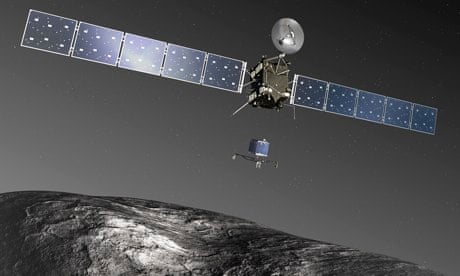


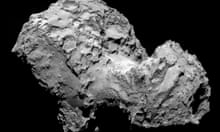

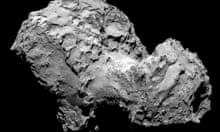

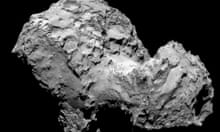



Comments (…)
Sign in or create your Guardian account to join the discussion